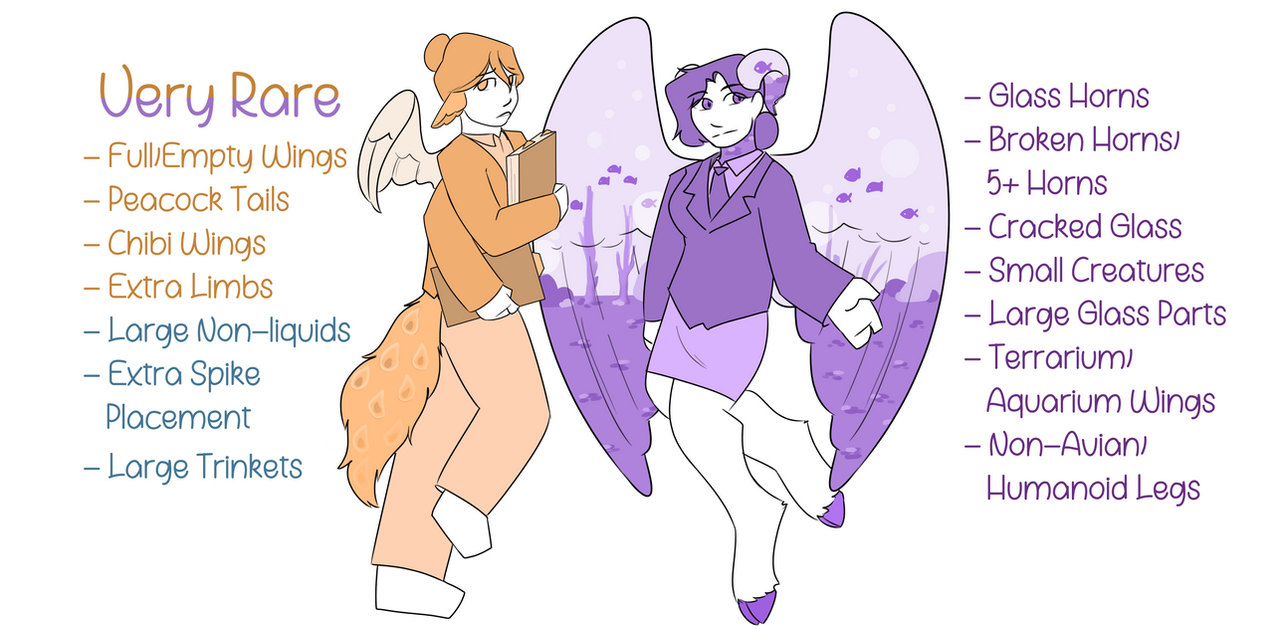HOME | DD
 ArlPoint — Trait Ref: Very Rare
ArlPoint — Trait Ref: Very Rare

Published: 2023-02-02 02:46:31 +0000 UTC; Views: 904; Favourites: 3; Downloads: 0
Redirect to original
Description
Full/Empty Wings -Wings with fillings that are either non-existent, or reach up to the very tops of the shoulders.
Large Non-Liquids -
Instead of liquid fillings, a Birdie may contain solids! Examples of large non-liquids would be rocks, gems, snow, or gears!
Peacock Tails -
Not all tails are just for show or convenience, some serve an actual purpose! Birdies flicks their tails (those who have them) when trying to find a partner, and everyone knows that a peacock’s tail is the most grand romance-magnet of them all. Exactly what you think, your Birdie can now have the magnificence of a peafowl!
Chibi Wings -
Small wings, when closed, will only ever reach to the elbow in length relative to the Birdie’s size.
Glass Horns -
Sometimes, when a Birdie grows horns the material may be glass rather than keratin. These special horns are a 50/50 on being filled, regardless of other traits. While typically straight, glass horns can take on any shape available in previous traits. Horns are now allowed up to five and beyond. Can be thick or hollowed; hollowed glass horns may or may not have fillings, but fillings always match the wings.
Broken Horns / 5+ Horns -
Broken horns can only be organic, and refer to when the horns are cracked or severed irreparably. Horns are now allowed up to five and beyond.
Cracked Glass -
While looked down upon, having cracked glass is not going to immediately get a Birdie thrown out of any establishment. These cracks can be in any glass body part that isn’t a wing, ie.: horns, arms, legs, et cetera.
Extra Spike Placement -
Glass wing spikes no longer have to be confined to the shoulders of the wings, and can be found in any placement on the wings, instead. Examples of this are on the base, protruding from the “feathers,” and on the wingtips, or any part of the body that is made of glass.
Large Trinkets -
Items other than the basic fillings that reside within the wings of a Birdie. Large trinkets may include things like large bones, big gems, sandals and the like.
Small Creatures -
Very rarely will a Birdie be born as not the only thing living in the egg. Sometimes, they’re born with animal life in their wings! These Birdies don’t always have anything special in their wings, but can host a wide array of little lifeforms! For example, a Birdie whose wings are full of adorable little kittens, frogs, or maybe even being full of small fish!
Large Glass Parts -
“Parts” here refers to areas of the bodies being replaced with hollowed glass. These parts are typically filled to the top with whatever fillings the Birdie has, but when combined with another trait may remain empty. Large body areas may include things like the neck, stomach, or an entire arm or leg.
Extra Limbs -
Your Birdie may have multiple arms or split legs, maybe even an extra head or tail! However, the exception to this is that they cannot have multiple wings for lore reasons, and cannot take on a centaur body shape.
Terrarium/Aquarium Wings -
Very rarely will a Birdie be born as not the only thing living in the egg. Sometimes, they’re born with plant life in their wings! These Birdies have rich soil in their wings that can grow certain kinds of plants! For example, a Birdie whose wings function as pots for succulent gardens.
Large Peep Forme -
While every Modern Birdie has a Birdie Forme, some are a bit more, ah.. big. With this trait, your Birdie can take on the shape of everything that isn’t mythical or extinct, from the tallest penguin to the tallest cassowary!
Non-Avian/Humanoid Legs -
Very rarely will a Birdie be born without avian or humanoid legs, but just as with the ears or tails, it’s not impossible! Examples of this trait can be unguligrade deer legs, digitigrade cat legs, or even plantigrade dog legs.

















